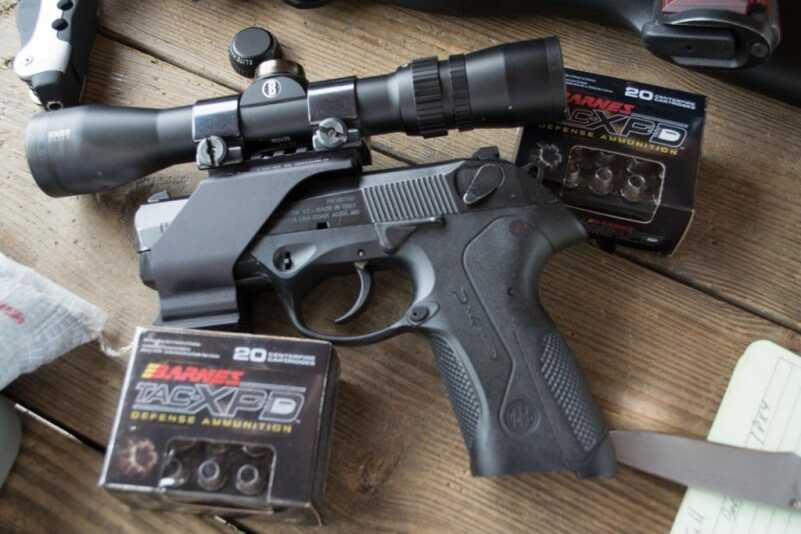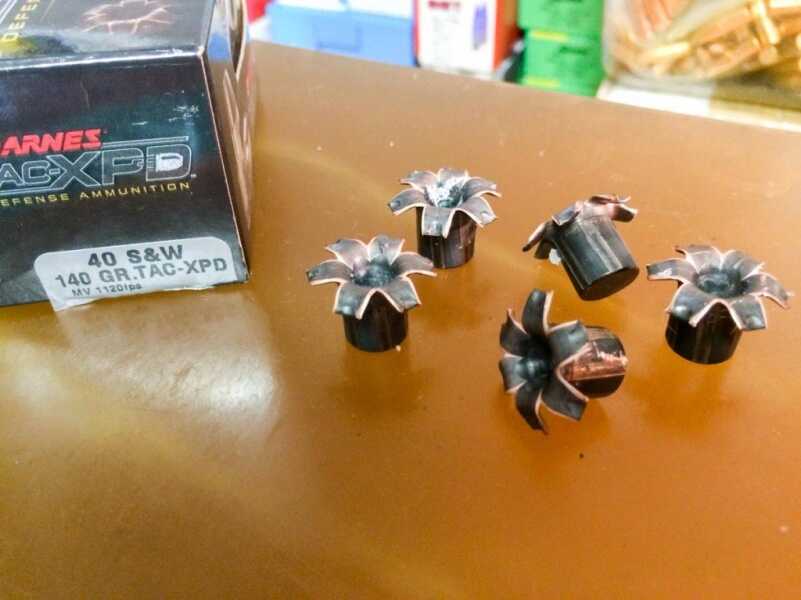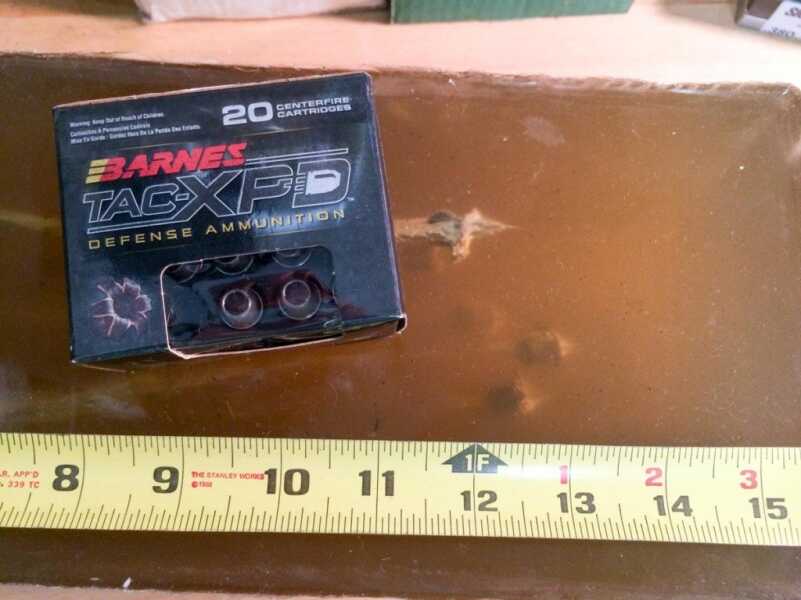Over the years, .40 S&W has been disparaged as a mediocre compromise round. You’ve probably heard some of the descriptions.
.40 Slow and Weak
.40 Short and Weak
 I’ve never really understood that. Sure, most cartridges have pros and cons relative to others, and as study after study shows, none are perfect. All handgun calibers represent some form of compromise. When it comes to one-shot stopping power, perhaps only the MK-19 Automatic Grenade Launcher has a perfect record.
I’ve never really understood that. Sure, most cartridges have pros and cons relative to others, and as study after study shows, none are perfect. All handgun calibers represent some form of compromise. When it comes to one-shot stopping power, perhaps only the MK-19 Automatic Grenade Launcher has a perfect record.
Maybe my obsession with reloading causes me to look deeper at the performance windows of various calibers. When I think about .40 S&W, I don’t automatically assume an 180-grain bullet chugging along at 900 feet per second. I think of the wide variety of loads available, ranging from light bullets like 125 or 140 grain zooming at 1,100 to 1350 feet per second all the way to the 200 grain head heavies moving at 950 feet per second.
Slow and weak? Not necessarily. A 125-grain bullet, larger in diameter than a 9mm, but moving just as fast or faster, is certainly nothing to sneeze at.
The bottom line is that the .40 S&W, like most other cartridges, offers a wide range of potential performance for various tasks. You get to choose the bullet type and weight that suits your intended use.

I tested accuracy using a Bushnell Elite 3500 Handgun Scope in order to eliminate “iron sight” error as much as possible.
On the “con” side, the only real complaint that some people have is the “snappier” recoil than either 9mm or .45 ACP. Since “snappy” is kind of a meaningless subjective description, let’s refer to Andrew Chamberlain’s Cartridge Comparison Guide to look at some recoil energy numbers. An “average” 9mm load with a 115-grain bullet moving at 1,250 feet per second generates 3.67 foot-pounds of recoil energy firing from a 40-ounce gun. A 230 grain .45 ACP moving at 900 feet per second rates 7.25 foot-pounds of recoil energy. The 180-grain .40 S&W moving at 1,020 feet per second measures 6.12 foot-pounds. That’s less than the .45 ACP, but almost twice as much as the 9mm. Subjectively speaking, to me anyway, the .40 S&W recoil is more of a “snap” while the .45 ACP is more of a “push.”
The Barnes TAC-XPD .40 S&W load chooses the velocity side of the spectrum as their 140-grain projectile is rated at 1,120 feet per second, which delivers 390 pounds of energy, measured at the muzzle.
Velocity
To check “real world” velocity, I set up a Shooting Chrony Beta Master Chronograph 15 feet down range and clocked velocity. My test gun was a Beretta PX4, which has a four-inch barrel. I expected to get less than the rated speed since the PX4 has a slightly shorter barrel, and I did.
Here are the results of a 10-shot string.
1: 1,045.0
2: 1,051.0
3: 1,050.0
4: 1,045.0
5: 1,042.0
6: 1,056.0
7: 1,049.0
8: 1,048.0
9: 1,042.0
10: 1,048.0
If you crunch the match, this works out to an average 1,047.6 feet per second. The extreme spread, or difference between the slowest and fastest shots, was only 14 feet per second. This yields a standard deviation, or measure of how close all shots are to the mean value, of just 4.30. That’s pretty incredible consistency.
Accuracy
To get an idea of how this ammo performs in regular guns (not fixed test barrels), I shot groups using two different pistols. The first was the Beretta PX4 Storm used for velocity testing. The second was a Glock 31.
For both guns, I mounted a Bushnell Elite 3500 handgun scope using a UM Tactical Universal Sight Mount. This 2-7x optic provides a perfect and precise sight picture at 25 yards, eliminating most of the human eye sighting error when shooting over traditional iron sights.
[one_half]

I was surprised at the accuracy from a Glock 31 (.357 Sig) using a Lone Wolf .40 S&W conversion barrel.
[/one_half]
[one_half_last]
[/one_half_last]
Average of 5-shot groups from the Beretta PX4 measured 2.05 inches, center to center. Looking a the best three of the best group, I came up with a group size diameter of 1.05 inches.
The Barnes TAC-XPD performed even better from the Glock 31. This is technically a .357 Sig pistol, but I have a Lone Wolf conversion barrel that allows it to shoot .40 S&W with no additional modifications. The 5-shot groups at 25 yards averaged 1.42 inches with a best three measurement coming in a just .77 inches.
Earlier, I noted the exceptionally consistent velocity of these rounds, and one of the ways that shows is in the accuracy.
Shooting the Jello
As this is a self-defense round, no test would be complete without some gelatin testing. As always, I shot it through the standard FBI heavy fabric barrier and into 10% simulated ballistic gel block. The firing distance, per the FBI protocol, was 10 feet.
Penetration depth into the gel block, after passing through the heavy fabric barrier, was nothing if not consistent. All five shots stopped at a penetration depth of between 11 ½ and 13 inches.
Expansion was a classic example of the Barnes all-copper TAC-XPD projectiles. All five projectiles expanded fully and measured .76 to .77 inches in diameter. That works out to 1.91 times the original diameter, well above the rule of thumb 1.5x expansion expectation.
Closing Thoughts
This is an interesting round. The light for caliber weight provides enough velocity to make expansion reliable, even through the four-layer heavy clothing barrier. That’s not easy to accomplish. Better yet, the felt recoil of this round was no big deal. The lighter weight projectile made recoil feel closer to a 9mm than a heavy .40 S&W self-defense round. If you read the previous ammo test here at GunsAmerica on the Barnes TAC-XDP .45 ACP round, you’ll notice that penetration was noticeably less than that of the .45 ACP. Those exceeded 16 inches for every shot. I suspect the lighter 140-grain weight and dramatic expansion performance cut the penetration level somewhat. Even still, the average 12+-inch penetration is nothing to sneeze at.




Belated response, but great review. As an experienced shooter/reloader for 44 Mag, 45ACP/357Mag, why would you want to shoot a 165-180 gr otherwise heavy bullet for CC/home defense? Newton’s 3rd Law of Motion applies here. I.e., the heavier the bullet, the more recoil, the more effort it takes to maintain control and focus on target. Practice at range with whatever you want or what is available/or what you can afford/or otherwise reload, but I carry for CC a 40 s&w, use a lightweight bullet such as a 140 Barnes mention by author or something similar in another brand. I have a Walther PPS M1 in 40 S&W and love it with a light weight bullet under 165 grains.
Nothing wrong with a 40 s&w at all. The snappy feel disappears after shooting it for a couple of weeks and even so many people prefer guns that have a bit more recoil than what is considered light. The .40 is excellent in the Glock 35.
Mr Mchale,
Thank you for this short article. Reviews of this particular weight of Barnes XPD arent very numerous. I was pleased to see a recent write up. From what I have seen/read, this appears to be one of the top, (dare I say top 3?) performing choices for a defensive .40sw round.
One thing I would love to see however, is how this performs out of a 16-17bbl carbine. With the added velocity from the substantially longer barrel, Im curious if this ammo would perform properly, or perhaps worse.
The test seems as proficient as I could do with the resources available to the general public. I also find in all (write-up) articles regarding Barns Products to be worthy of selective purchase over the competitive makers similar product’s. How would I determine the precise load components to Re-construct this Cartridge from raw manufactured component’s. My difficulty with this and other Ammunitions packaged for sale is the price at the retail level. I not a cheap skate but I’m angry at the markup and shipping fees being paid out for shooting supplies. If I can make this and shoot this regularly, that would be fine.